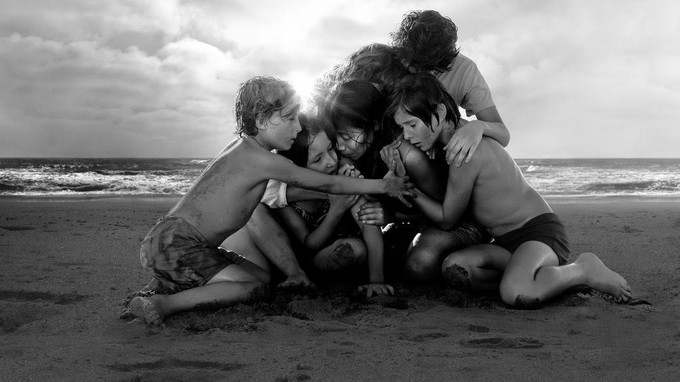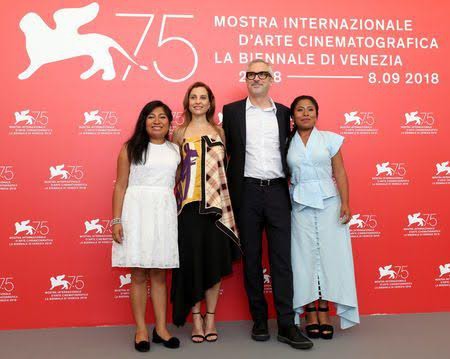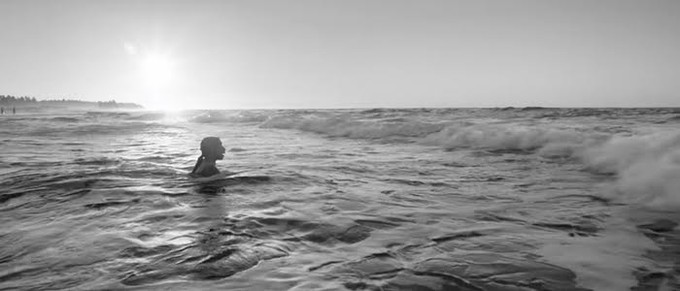
ROMA, so named after the Colonia (neighborhood) in Mexico City in which the protagonists of the story reside, is a film of contrasts. It deals with family and the utter lack thereof. It is shot in luxurious, old-fashioned black and white yet it is tweaked by top-of-the-line digital effects and sound, the film was set in 1971. The film views its third world microcosmos with an unblinking, contemporary eye which adamantly refuses to put on, at any moment, the tint-colored glasses of nostalgia; it deals with both longing and belonging; it both wrenches and warms your heart.
It is extremely easy to view this- Alfonso Cuarón’s next effort four years after winning his Oscar for Best Director- as something of a self-congratulatory, pretentious follow-up, more interested in ingratiating itself with the critical elite than in connecting with the same moviegoing crowds that turned Gravity into the blockbuster it was. And it indeed aims for wildly different goals- with its period-set, Spanish-spoken, indigenous female newcomer-starring credentials how could it be otherwise?- But ROMA never even crosses the line into or even steps close to becoming Art House-bait.
Cuarón- reportedly admitting as much- goes back to a fictionalized version of his early years, growing up as one of the kids in a privileged family- dad is a doctor, mom studied Chemistry- on the brink of divorce. However, and contrary to what most storytellers choose to focus in on during these kinds of trips down memory lane, the part he- and the rest of his family, for that matter- ends up having in the film is barely more substantial than an extra’s. ROMA feels, regardless of whatever the filmmaker’s real motivations were, like a willful, retroactive appreciation for the care the family’s criada (maid) gave them all.

This is the story of Cleo (played by Yalitza Aparicio), one of the two girls of Mixteco descent who tend to the family’s every need, and if the movie feels like one thoroughly simple story told in in an expansive canvas it is precisely because Cleo’s life is that simple- if not easy. We carefully follow her daily comings and goings, and it is not until it starts feeling lethargic that the point of the apparently senseless, unarguably elliptical nature of her existence hits home. We witness how she cooks, sweeps and mops, does the laundry, feeds the dog, cleans its shit (or forgets to do so), tucks the kids into bed, listens to their babbling. She even manages to take thirty seconds to sit down with the family and laugh at a comedy-sketch T.V. show before something else comes up and gets her back on her way.
We meet her boyfriend Fermín (Jorge Antonio Guerrero), a former hoodlum turned current despicable martial arts aficionado and overall jerk, who shamelessly walks out on her (literally leaving the theater wherein she tells him she is pregnant even before the movie ends) without looking back. We see how her employer, Sra. Sofía (Marina de Tavira), gets the family’s pediatrician to check her after empathetically hugging her, patting her head and calling her “mensa, mensa” (something like “idiot”).
When, some time afterward, Cleo manages to locate her baby’s deadbeat father we are treated to an extremely ambitious sequence detailing Fermín’s group training, led by real-life Mexican mentalist/hypnotist/escapist/martial artist Profesor Zovek (played by real-life Mexican wrestler Victor Manuel Resendiz, “Latin Lover”). The staple of early seventies Mexican variety shows asks the humongous group of samurai-wannabes and assorted onlookers to emulate the position of his body, a feat, he assures, only Lamas, great martial arts Masters and some great athletes can achieve (arms upright, hands together, right leg up with its bent knee, right foot on left knee, keeping still). After everyone easily does, he asks them to now close their eyes. Cuarón frames the subsequent domino-like fall of arms wavering for balance with a wide shot covering the entire screen and, smack-dab in the middle, stands Cleo, firm, motionless, eyes closed, the single one person achieving perfection.
From there, if there had been any doubt whatsoever, it is completely clear where Cleo stands within the parameters of flat-out decency/morality established by Cuarón’s screenplay and when her baby girl turns out to be stillborn-as shown in a raw, matter-of-factly sequence- it is impossible not to feel invested.
The climax, an extended single shot following Cleo as she enters a rising, increasingly violent tide to try and bring two of the children back to safety showcases, to my knowledge, the most flawless, seamless use of digital effects and editing that I have ever seen. It is the personal context that actually makes it worthwhile, at once threatening to sink you and desperately fighting to keep you afloat. This is, instantly, an all-time classic sequence.
Both artistically and technically, ROMA is a literal, ultimate masterpiece in a career that includes triumphs like the aforementioned "Gravity," "Children of Men," "Harry Potter: The Prisoner of Azkaban" and "A Little Princess." Cuarón, acting again as editor and, for the first time, serving as his own Director of Photography, blocks, frames and shoots with utter confidence, demonstrating an imagination for visual flair on par with longtime collaborator Emmanuel Lubezki and an awe-inspiring perception of rural vistas reminiscent of the legendary Gabriel Figueroa. The ambition already evident ever since twelve years ago when he implemented the long single takes in Children of Men (which, arguably, set the trend ever since) has evolved and reached new levels in which, by using an admittedly less flashy approach, he creates unbearable levels of tension depicting student riots and police brutality with a slow panning shot.
The performances cannot be lauded enough. Aparicio makes the most of this, her likely once-in-a-lifetime shot at leaving a truly legendary cinematic legacy behind and how close character and actress are to each other is beyond the point; her naturalism is absolute and devoid of any possible reproach. Verónica García, playing the grandmother, is pitch perfect in her depiction of the prototypical Mexican catholic matriarch and the children, minimal as their contributions are, offer the vital blood to pump life into this family’s believability.
The production design is lavish, and it brought to mind the painstaking attention to detail evident in epics like The Godfather Part II and Once Upon a Time in the West. Efforts that go way past merely depicting a place in time and force you to almost smell the scents and actually be there. A simple shot of Cleo crossing a street in Mexico City seems to reach the distant urban horizon filled to the brim with a cityscape, a sea of vehicles and a swarm of people all in their corresponding seventies period states. All wholly unnecessary and, at the same time, absolutely thanked for.
When the kids, their mom, and Cleo are finally back, grandma receives them with open arms and listens as they tell them how they almost drowned, how they would have most surely died if Cleo hadn´t intervened and saved them. Then, with the same breath, they ask Cleo to fix them a snack, please. Life goes on and even although her own existence promises to continue being the same neverending loop- and even if that family which is not her own doesn´t feel the same as she does. Cleo proves that you don´t have to reach the flying miracles up above- not even acknowledge them, really- to find some sort of fulfillment, that you don’t have to be loved in order to love.
Eloy Ricardo Balderas Salazar

